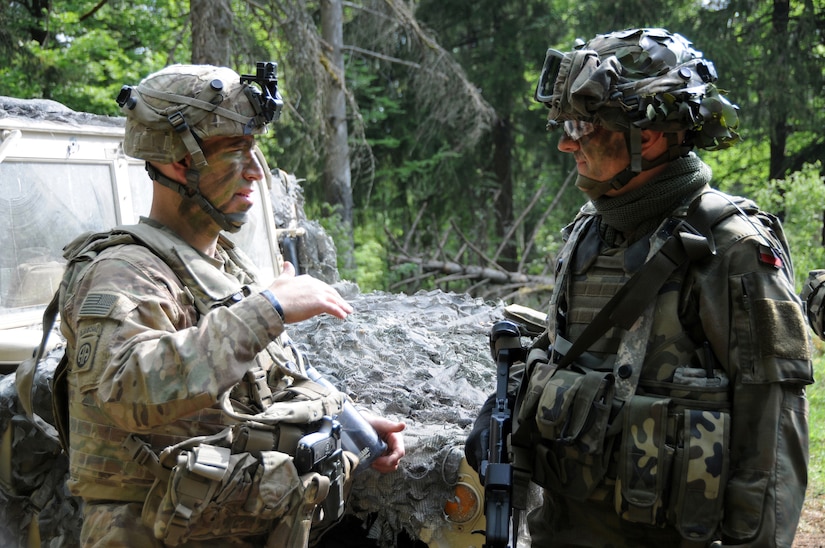By Army Sgt. Brian Schroeder, Joint Multinational Readiness
Center
HOHENFELS, Germany -- Participants at the multinational
Combined Resolve X exercise conducted here April 9-May 12 are being asked “to
understand other cultures and different ways of thinking,” said Polish army
Command Sgt. Maj. Andrzej Woltmann, the 12th Mechanized Division’s senior
enlisted advisor.
“We can help each other if we know some phrases in other
languages, but we have to try and use the military terms according to NATO
guidance and not try to literally translate procedures to our national
language,” Woltmann said. “At the end of the day, the mission objectives are
the same.”
The exercise includes approximately 3,700 participants from
13 nations at the 7th Army Training Command’s Grafenwoehr and Hohenfels
Training Areas.
In an area known as “the box,” coalition forces, led by the
Polish army’s 12th Mechanized Division, with soldiers from Lithuania, Romania,
Albania, Kosovo, Macedonia, Georgia and the Czech Republic, square off against
an opposing force comprising U.S.
soldiers assigned to the 1st Battalion, 4th Infantry Regiment and soldiers from
the Ukrainian, Slovenian, Romanian and Latvian armies.
Know Your Allies
“In order to be an adaptive leader it is very useful to know
your allies and make sure everybody is on the same operational page,” Woltmann
said.
In an effort to standardize language across the 29 member
nations, NATO has designated English and French as the official languages.
Army Sgt. 1st Class Randon Sander, explosive ordnance
disposal observer coach/trainer for the Joint Multinational Readiness Center
Raptor Team, said communicating with troops from different countries can be
challenging during training.
“Luckily for me, our career field is pretty black and white;
like a math equation,” Sander said. “It doesn’t matter what the language is,
there is one way to make an explosive. Electricity, circuitry and explosives
all work in the same way. I can tell they get the big picture because when I
watch them run full throttle, I can tell they are thinking the same things I
am.”
Body Language, Gestures
Body language and gestures are also used to communicate in
multinational medical units. Polish Cpl. Pavel Witkowski, a paramedic assigned
to 12th Command Battalion, 12th Mechanized Division, said he has worked with
U.S. soldiers in Afghanistan on multiple deployments. Although the
accessibility of translators on cell phones and the internet have cut many language
barriers, he said the technology can sometimes get in the way in a medical
emergency.
“Sometimes we must say something quickly, but do not know
how to say in a different language,” Witkowski said. “We use simple words and
our hands if we don’t know the word if we want to say something when we are
working on a patient.”
The Kosovo Explosive Ordnance Disposal Company, Kosovo Civil
Protection Regiment, comprises various cultural backgrounds including Albanian,
Turkish and Bosnian. Soldiers in this unit can speak English, Turkish, Serbian
and German. Kosovan soldiers can volunteer to receive language training in
English, as well as German, three times per week. Capt. Gezim Sada, EOD
Company, Kosovo Civil Protection Regiment deputy commander, said he encourages
his soldiers to learn English because it is a common language spoken around the
world.
“It is good if everybody can speak another language, but we
try to push for everybody to learn English because you cannot go anywhere
without English,” Sada said. “We have to adapt with the field and how things
are going on the battlefield. It would be difficult for U.S. soldiers to learn
Albanian, but it is not easy to learn English, either.”
Knowing he would be interacting with the Polish army, Col.
David W. Gardner, 2nd Armored Brigade Combat Team commander, took it upon
himself to learn Polish before the exercise. He said having the ability to
speak simple phrases in Polish might help him come across clearly to his NATO
comrades on the battlefield.
Communication
“One way you can demonstrate you are committed to your
allies is to try and return the favor by learning their language,” Gardner
said. “It can be something simple as just saying somebody’s name properly. I
think it is a sign of respect.”
Adriana Zakk, a Polish Army psychologist, said being fluent
in a foreign language is not a requirement to communicate with somebody from a
different country. Simply knowing basic phrases in a foreign language is
showing international courtesy.
“It is about having openness,” Zakk said. “If a soldier from
the U.S. or Italy speaks to a Polish soldier and says ‘ dzien dobry,’ or good
morning, this is collapsing the cultural barrier. Then you can speak English.
When you are working in an international environment, it is about being
flexible all of the time.”
Woltmann said understanding a different culture is the first
step in accepting differences between your native land and a foreign country.
Knowing how to communicate is secondary.
“You should not be ignorant,” Woltmann said. “We have to
start with ourselves if we want to learn a new language. If you are coming to
Poland, Germany, Czech Republic, it is very good to learn some phrases first.
Knowing the culture is most important. Language just helps you to break that
cultural barrier.”
Combined Resolve is a U.S. Army Europe-directed
multinational exercise. It is designed
to give the Army’s regionally allocated combat brigades in Europe a combat
training center rotation with a joint, multinational environment.









No comments:
Post a Comment